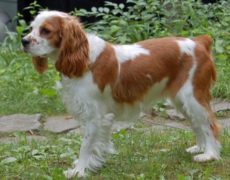Cockalier
The Cockalier is a cross breed between the Cocker Spaniel and the Cavalier King Charles Spaniel. With both its parents being spaniels, the cockalier falls under the general spaniel breed. They commonly come in shades of brown and white.
The shape and size of the dog completely depends upon the ruling gene inherited from either of its parents, with some cockaliers being short and stocky, while the others are tall and slim. These long-haired lapdogs are marked by dark eyes and long, floppy ears. Because both of its parents belong to the spaniel group, the cockalier’s characteristics are easier to predict, as compared to the genetic parent-baby relationship of other hybrid dogs.
Cockalier Pictures
- Black and White Cockalier
- Black Cockalier Puppy
- Black Cockalier
- Cockalier Dog
- Cockalier Images
- Cockalier Photos
- Cockalier Pictures
- Cockalier Puppies
- Cockalier Puppy Images
- Cockalier Puppy Photos
- Cockalier Puppy Pictures
- Cockalier Puppy
- Cockalier
- Full Grown Cockalier Dog
Quick Information/Description
| Also known as | Cockalier Spaniel |
| Coat | Fine, curly |
| Colors | White and brown (commonly), Black & Brown, Black & White, Brown & White, Chocolate, Dark Brown, Golden, Merle, Red, Speckled, Spotted, White |
| Breed Type | Crossbreed |
| Group (of Breed) | Toy dog, lap dog, designer dog, sporting dog |
| Lifespan | 12 to 15 years |
| Weight | 10-28 pounds |
| Height (size) | Small to Medium; 12-15 inches |
| Shedding | Moderate |
| Temperament | Intelligent, loving, loyal, playful |
| Good with Children | Yes |
| Good with Other Pets/Dogs | Yes |
| Barking | Rare |
| Hypoallergenic | Yes |
| Litter size | 3-5 puppies |
| Country of Origin | USA |
| Competitive Registration | ACHC, DDKC, DRA, IDCR, DBR |
Temperament and Behavior
They are always eager to please their family. Being social by nature, cockaliers would easily bond with people. They are playful, and are good to kids. Although, given their size, the dog might easily be hurt while playing with them.
Cockalier is a non-aggressive, calm dog that seldom barks. Although, they are wary of strangers. This intelligent dog would learn things very easily and make a great family pet that are ideal for apartment life.
Cockaliers need attention. So, be sure you give it enough company, or else your dog might easily develop separation anxiety.
Cockaliers are natural hunters. Try keeping them indoor, except during exercising, if you don’t want them be a ‘hunter’.
Care
Exercise
Cockaliers are energetic and their playfulness demands lots of activities. With their love for swimming, they would take quick interest in water sports, especially retrieving games. Take them out every day for brisk walks and jogs, which would keep them in a happy mood, and would refrain them from any possible destructiveness. These dogs do not need a lot of space to play. Allow them play unleashed in a safe, enclosed area.
Grooming
The coat of the cockalier is prone to get matted easily, and need to be brushed at least once a week. Special care is advisable during shedding periods. In this regard, you can also seek for professional help.
Health Problems
Ear infection is common to those individuals that have predominant genes from their cavalier parents. Take care of your dog’s ears especially if it spends time in water.
Training
Cockaliers can very easily pick up commands and tricks. You need to be a calm and consistent trainer to train the modest and loving cockalier. Be strict and define rules clearly to be its ‘pack leader’, so as to avoid possible ‘small dog syndrome’ in the future. Train it to socialize from its puppy days. Crate training is also easy, provided you keep the sessions short. Insist on being generous with positive encouragement and compliments.
Diet/Feeding
Feed your cockaliers with general high-quality dog foods, recommended for dogs of the same size and energy level. Some cockaliers are pickier than the others. As a change, you can also try cheese, bread, peanut butter, vienna sausages etc.
Interesting Facts
- Cockaliers are generally a happy breed that would very frequently wag their tails to express pleasure.
- The texture and density of the coat varies between individuals depending upon the ruling parental gene.



















